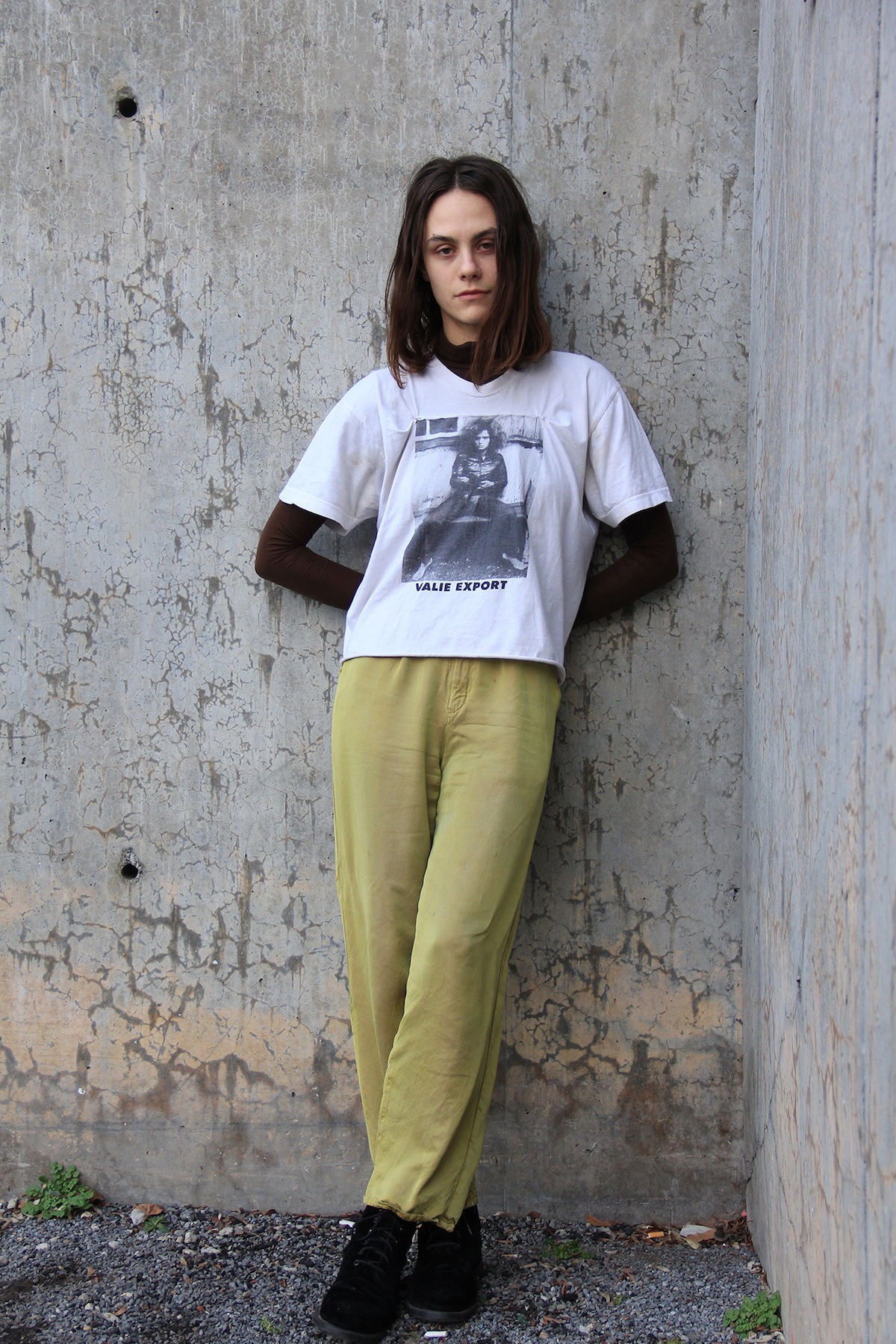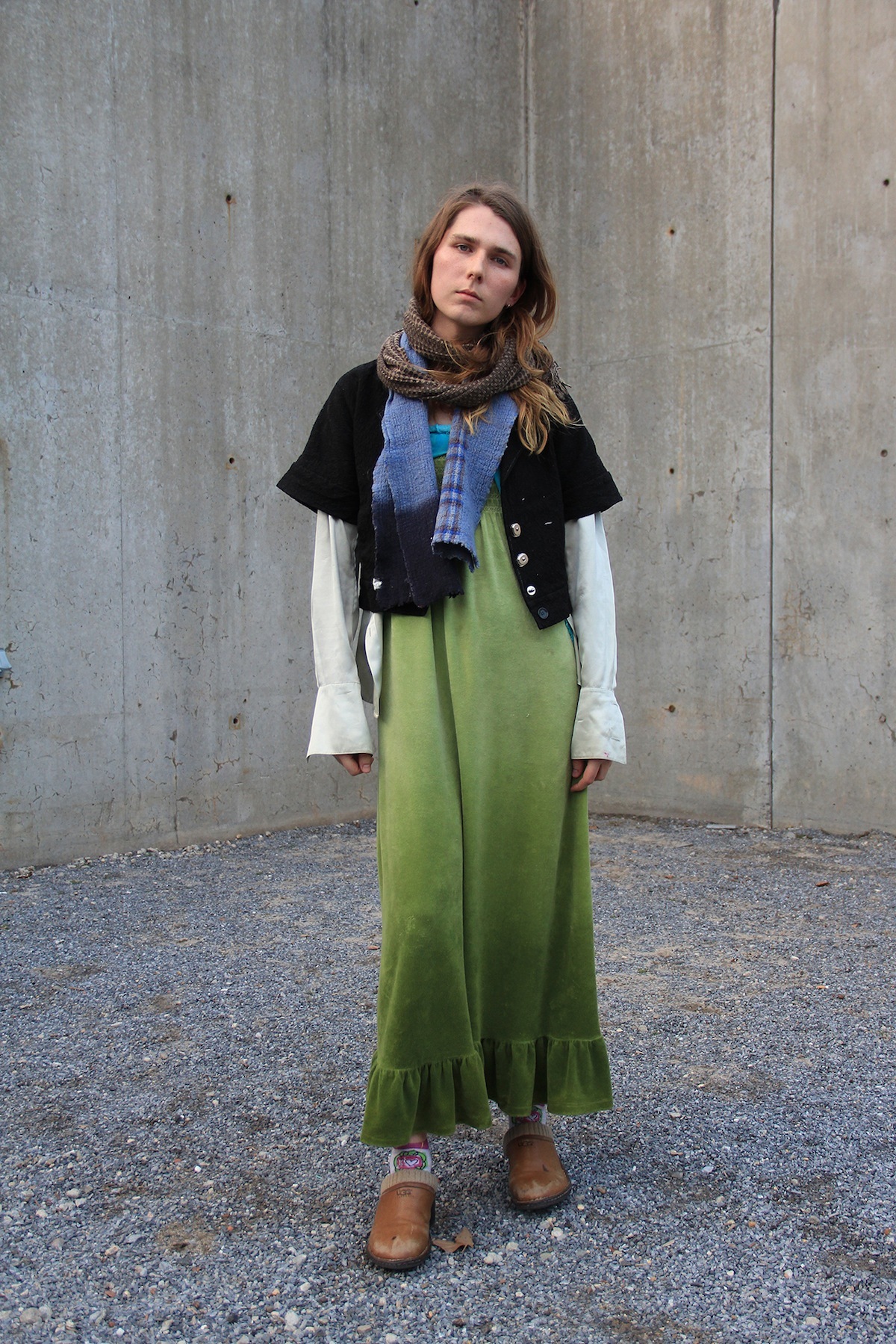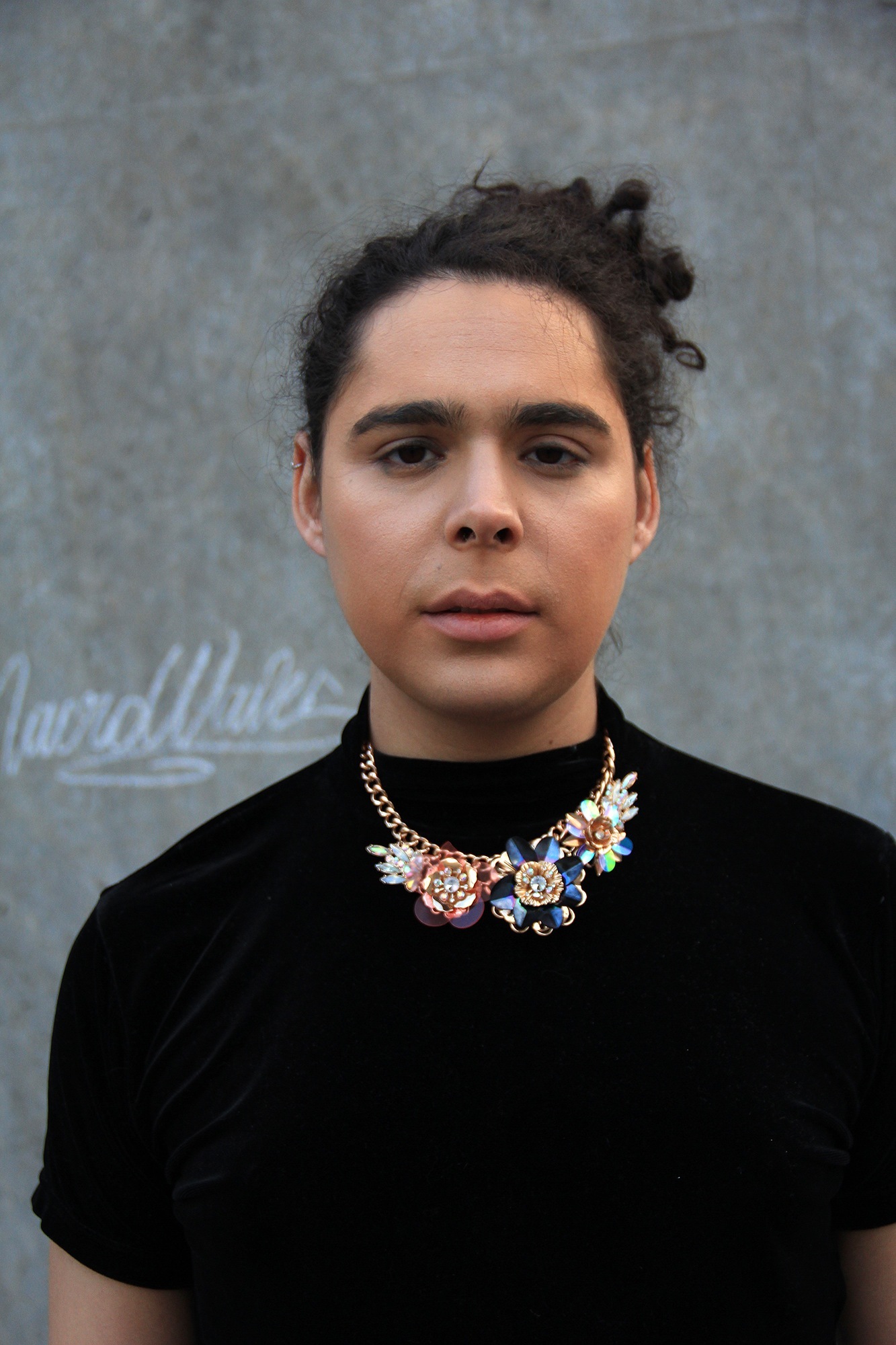This Sunday, artist, actress, and activist India Salvor Menuez will bring together a group of multidisciplinary artists for Crumbling World Runway, an iteration of MoMA PS1’s new series of Sunday Sessions. Performers include Maria José, Sara Grace Powell, Rowan Oliver, Ser Serpas, Women’s History Museum, and Ariel Zetina. Together, they’ll create work that engages with “queerness, trans-feminine social dissonance, the othering of women, out identity, the symbolic connotations of garments, and collective consciousness,” according to PS1, through performance, poetry, and music. Ahead of Crumbling World Runway, we asked India to interview the designers, visual artists, writers, and performers she invited to partake in the multifaceted piece to discuss its themes of identity, community, and expression.
Can you tell me about your practice? Some of you don’t work primarily in performance. Can you talk about your preferred mediums and how you have come into making the work you currently do?
Ser Serpas: I work a lot and too much and not enough. Things I’m making now are trainwreck survivors.
Maria José: I have a performance background. I grew up training to be a musical theatre performer. I briefly pursued a degree in Theatre at the University of Puerto Rico. Then, I moved to New York and transferred to Parsons, where I completed a BFA in Photography. While studying photography my main focus was self-portraiture, which can be understood as performance. After graduating, I did live performance for several months. I never stopped engaging with performance.
Rowan Oliver: I work with image and writing and storage, memory. I guess also in, ideally, transference and illumination. I like to find the best potential places of impact.
Sara Grace Powell: Currently trying to make as little physical work/waste as possible, which results in different kinds of disappearing acts. In 2010 I started going to openings as this persona, Kelsea Wollffllotterr. I’ll be performing as them on Sunday – they’re a failed art advisor and life coach who entered the art world as this impostor even as I navigated these spaces of and with privilege. It’s satire suffering from sincerity. Their name is so visually ridiculous there’s no suspension of disbelief – because accessibility is important to me, when people are in on the joke.
Ariel Zetina: I mostly work as a club music DJ in Chicago, so most of my work is synthesizing my own sounds and sounds of others into longer form pieces over the course of a whole night. I come from a background of theatre (playwriting mostly), performance, and poetry, which is all still prevalent in my work.
Women’s History Musuem: We primarily make fashion objects that may become performative, but we are not performers ourselves.

What are some themes you are personally exploring in this new piece? Are some of these themes ones you always work with?
SS: I inverted a method of prison planning — Jeremy Bentham’s Panopticon specifically — without realizing. My collaborator on documentation and film, Rin Johnson, pointed it out, and I was like, ‘oh shit, I guess this is how one reacts when being watched in public over time, as racialized threat or object in commerce.’ Its been with me since being young and surveilled in my childhood neighborhood, on campus, even before I inhabited a mostly white space as I do now matriculating at Columbia. Like I hate getting stopped at the gate for student ID; fuck that school, you know?
MJ: A lie told with authority can be perceived as truth. The piece I am presenting with Ariel Zetina for Crumbling World Runway is about climate change and denial. Facts vs. non-facts. I consider myself a Surrealist, so I have walked the line between what is real and what isn’t before. However, this is my first work that does not explore identity.
RO: The theme of waking up and you’re an insect, and also that feeling of a blanket being torn off you. As well as the theme of the organized left struggling with ethics and progress and freaking out about it.
SGP: Performance as ’emergency action’ (i.e. a response to a perceived threat) and the utter inadequacy of that sentiment if its end result remains hermetically sealed in an art context. Also considering a familiar theme of being seen and unseen by documentation as well as reflecting on whose feminism(s) matter and why.
AZ: Maria and I explore methods of discussion and communication in regards to social and political issues, in this case, climate change. By dissecting media’s language around this, and presenting it through alternate mirrors — as electronic music, as one performer embodying multiple voices — information becomes less clear but more connected to the human body and to perhaps elicit an emotional response.
WHM: We are acting as assistants to Ser. Our task is to clothe her, apart from bringing her vision into fruition.

What are your feelings on the political implications of your work? I have noticed in certain dialogues a new awareness of how all work can be political — how there sometimes is no escape from that. Do you think, and if so how, can art effectively make political change?
SS: Ehhh, depends on who’s in the room. I’m more interested in extracting content from institutional settings than I am about performing in the institution, I guess.
MJ: I do not believe art has the power to change our political circumstance. However, Art, apart from being an individual’s expression, is a multi-billion dollar industry. If money were to be distributed differently, change would be possible. Do I expect this to happen? No. The rich have a hard time sharing. Men have a hard time letting go of power. White folks will appropriate the revolution, put it up in Chelsea, and profit off of it.
RO: Political art made by marginalized groups with concerted efforts to shift a cultural landscape towards people of color, with appropriate compensation, should be the art that succeeds in institutions. If those institutions are aiming to facilitate or assist culture by reaching an expanded public, dialogues about all work being political might be about, say, the works in art fairs bought to take the place of a bank (with higher returns) for someone’s $40 million. If you can relocate money through art with intention, and do it well, that can be political. There is a lot that people want to do that is not made possible by those who hold wealth, and this generation is being held back from enacting many things more transformative than art. Currently, art is trash; so much of it is either a vessel or about nothing but the artists’ privilege, but it could be so much better. Or maybe it cannot be.
SGP: Sadly I think this new awareness is two faced. Institutional Critique has become the new normal. Kelsea Wollffllotterr is kind of capitalizing on that. Art is only politically effective if it inspires someone to act outside of an institutional/Art setting, mobilizes change outside of art in and of itself…and of course that depends on who can see what, when.
AZ: All my work will always be political whether I like it or not because of the body I am in. I don’t really have a choice. Art can affect change but it’s pretty hard to measure. But if you get rid of art and artistic institutions, the world becomes fascist, so it keeps that from happening.
WHM: Unfortunately not all art can be political. We think of this as a contemporary cop out of many to elide into lazy statements and piggyback on their own liberal elite privilege which is the industrialized art school environment that most work is churned through. We don’t believe everyone has the right to make art, and certainly not call it political.

You are making individual works, but there is an element of collaboration in how the work is coming together. Can you talk about how elements of your process splinter between the individual and the collaborative? How interested are you in collaboration? How important is it for you to see your work as distinctly your own?
SS: I’m so happy to be able to collab with WHM. It’s a dream, and we’re dreamscaping.
MJ: I am a portrait photographer; I totally depend on collaboration. [There is] a voice inside my head says that it is important to see my work as distinctly my own… and a louder one says there is no need to make such distinction. I understand the future is collaborative, and that the upcoming Renaissance must place the communal above all, instead of the individual. Holding the reins of our ego is simpler said than done, but it is necessary.
RO: It’s so sweet when friends are kind enough to help me with a performance or allow me their time; it should be a considered communication and interaction when you work with someone else. I’m always looking out for genuine moments and exchanges, and when you work with someone and leave possibilities open, you can create really unique feelings and even environments.
SGP: It’s unrealistic but I don’t necessarily believe in distinct work. There’s always something invisible or erased. I try to warp time and get you to consider what you aren’t seeing by being really myopic — kind of like negative multiplication. My piece for this developed in response to what I heard other performers say in our discussions, and it’s going to take place over a strange, permeable timeline.
AZ: I have always been a collaborator. Most of my work was always collaboration, but I have always liked when that collaboration involves a lot of my work alone, which is why I’ve always been interested in collaborating with text and sound as my medium. Maria and I worked together on my play British Honduras Fantasy in June — she played a character based on my own experiences — so we have an understanding of our own personal processes in a larger context. I think it will be clear what work is our own solo work, even though our piece is very collaborative.
WHM: We’ve collaborated with Ser before and she has been the one of the most vital performers in our collections. Her and her mother are starring in a film we’re working on as well. We never see our work distinctly as our own, and always comes to life when it interacts with participants and collaborators.

How do you feel about the context of the PS1 dome for the work you are making? How much does the context in which you are showing work inform how you approach making it?
SS: This piece will depend on the dome and the circle. Kinda anal that way, which is right up my alley.
RO: Oily space.
MJ: My work does not rely on the space, but I am grateful to perform at the PS1 dome. The technicians are incredibly helpful. They are working diligently to push each performance to its full potential.
WHM: We had no choice in the matter and are merely Ser’s assistants and couturiers.
SGP: Most of my work is site specific and there’s a lot to work with here — the temporary nature of the dome, the corporate sponsorship…
The show is titled Crumbling World Runway and was originally planned to take place during New York Fashion Week. Can you talk about how the work you are making relates to or, is in dialogue with, the fashion world? Can you share how — if at all — you consider the fashion world in your overall practice?
SS: I used to be a stylist’s assistant, and I love clothes.
RO: Normalized editorial lifestyle as a call for global automation and labor emancipation?
AZ: I think mostly the fact that I’ll be onstage during Fashion Week in pedestrian clothing and daytime makeup. I dress for my gigs and that changes depending on what that is. Because my work at MoMA PS1 is decidedly not about my own body (but will always be about my body when I am onstage), I hope to show the fashion world that trans women don’t always need their body to make work, but that their body ends up always being the tool that is necessary, even if it’s not seen.
MJ: At first I was planning to create a poetry piece that focused on modeling as a trans woman, but I chose to do something entirely different. My art practice rarely considers fashion, aside from it being a potential source of income.
WHM: Cloth is the seed seed of all our work, yet not everything we do is related to clothing or will be clothing. The tragedy of the cloth body interaction is one that we as a kind must always face and thus to ignore would be a lie. We are situated somewhere on an assembly line of rags that connects women oriented personas throughout the world. Even if we never get off this conveyor belt, our traces will cling to its rubbery surface until the entire world burns.
Who is someone making work now that you are inspired by — someone you think more people should become aware of and celebrate?
SS: All my friends make amazing stuff. I’m in a league of people inspired by Winslow Laroche, his body of work, his presence, and moral code.
AZ: Pollination Tech aka Alessa Schmalbach — a DJ, performer, and model based in Chicago who makes some of the craziest hard techno/industrial/electro sets I have ever heard in my life. Her makeup and performance skills are out of this world.
MJ: Artists I have met in the United States: Theresa Chromati, Marcs Marcus, Brooks AdaLioryn, Jazmin Jones, and Yeelen Cohen. Artists from Puerto Rico: Rubén Rolando, Lulú Varona, and Kuniklo Collective.
WHM: Ser Serpas, Marcelline Mandeng, Dachi Cole, Candice Williams, Gogo Graham, Gabriela Rivera Morales, Rare Candy, Odwalla 88, Via App, Elysia Crampton, Keke Hunt, Justine Crawford, Molly Edminster, Orion Facey
SGP: Right now a sweet mix of peers and scientists: Julia Braiman-Rothblatt, Brandon Ndife, Natalie Casagran Lopez, Ian Markell, Chien-Shiung Wu, Paul Dirac.
What other projects are you working on that you are excited about?
SS: Residency applications make me wanna hide forever, but snagging a few would help kick off my post-school life, so I’m just reflecting on that.
RO: In 2017, more facilitation of others’s output than my own. Also acting in more independent films.
AZ: I’m about to release a club music EP on Paris-based label Boukan Records. Other than that, working on some new mixes for some series I really respect, playing gigs, making more music.
MJ: I am working on a series of portraits rooted in responsibility. The current collection will be in conversation with a series of portraits I finished two years ago. Hopefully, I will publish a photo book by the end of the year.
WHM: We’re coming out with a line of life-like dolls that will be hitting your average NYC boutique and will be wildly profitable for the brand. We’re looking to open a Maison upstate that will serve as the couture setting for this generation.
SGP: Working on a therapy hotline coming soon to publication advertisements near you.
MoMA PS1 presents Sunday Sessions, ‘Crumbling World Runway’ curated by India Salvor Menuez. Click here for more information and to purchase tickets. A special thanks to Alex Sloan from PS1 for inviting India to curate this event.
Credits
Text India Salvor Menuez
Photography Maria José
